When you're seeking a book on practical spiritual living, you want to know that it is based on an authentic tradition of timeless teachings and that it resonates with integrity.
This is the goal of Crystal Clarity Publishers: to offer you books of practical wisdom filled with true spiritual principles that have not only been tested through the ages but also through personal experience.
Started in 1968, Crystal Clarity is the publishing house of Ananda, a spiritual community dedicated to meditation and living by true values, as shared by Paramhansa Yogananda and his direct disciple Swami Kriyananda, the founder of Ananda. The members of our staff and each of our authors live by these principles. Our work touches thousands around the world whose lives have been enriched by these universal teachings.
We publish only books that combine creative thinking, universal principles, and a timeless message. Crystal Clarity books will open doors to help you discover more fulfillment and joy by living and acting from the center of peace within you.







TABLE OF CONTENTS
CHAPTER
PREFACE
 ost of the verses in this edition of the Bhagavad Gita were taken from my much larger book, The Essence of the Bhagavad Gita Explained by Paramhansa Yogananda. That volume contained also deeply insightful commentaries on one of the great scriptures of the world, containing, as the "Gita" does, the essence of the Upanishads, which in their turn offer the essence of the timeless Vedas, the scriptural lore of ancient India.
ost of the verses in this edition of the Bhagavad Gita were taken from my much larger book, The Essence of the Bhagavad Gita Explained by Paramhansa Yogananda. That volume contained also deeply insightful commentaries on one of the great scriptures of the world, containing, as the "Gita" does, the essence of the Upanishads, which in their turn offer the essence of the timeless Vedas, the scriptural lore of ancient India.
Included in this edition are a few verses that were omitted from that larger book. They include most of the first chapter (which that book only summarized), and the first ten verses (slokas) of Chapter Two.
I found it expedient to the flow, when writing the larger volume, to omit these slokas. As the reader studies them in this compendium of the entire Gita, I hope he will understand why I only summarized this material at first. These omitted verses form, in themselves, an almost complete dissertation.
I should add that it was owing to these first verses, particularly, that I conceived from the beginning an intense enthusiasm for my Guru's further commentary.
I urge any reader who feels benefited by these pages to take the trouble (assuming he has not done so already) to read the much larger volume, mentioned above. As my Guru, after finishing his mammoth work, stated to me with deep bliss: "Millions will find God through this book!"
CHAPTER ONE
INTRODUCTION
 the Mahabharata, and the Bhagavad Gita of which it is a part, is not literal history. Rather it is a deep spiritual allegory, woven upon a framework of history. The main characters in the story did actually live, but they became essential reference points around which the story was developed. Most of the characters are inventions. They trace their names to Sanskrit roots, which supply their psychological meanings.
the Mahabharata, and the Bhagavad Gita of which it is a part, is not literal history. Rather it is a deep spiritual allegory, woven upon a framework of history. The main characters in the story did actually live, but they became essential reference points around which the story was developed. Most of the characters are inventions. They trace their names to Sanskrit roots, which supply their psychological meanings.
Arjuna was, in fact, a very high soul; Krishna, later in the Bhagavad Gita, calls him "Prince of Devotees." Yet in this short, but very profound, scripture, and especially so in this first chapter, he plays the role of mere spiritual beginner starting out on his spiritual search. The device can prove confusing for readers, sometimes, especially for those who are already fully aware of Arjuna's greatness.
The characters listed in this first chapter are not, as must at first seem, a mere catalogue of warriors arrayed against one another in preparation for the coming war. Instead, they symbolize psychological traits and states of consciousness, each of which plays an important role in the devotee's struggle to rise above worldly delusion and to reclaim his true state of Sonship to the Infinite Lord.
Because some of these states of consciousness appear only as the devotee develops further, and even highly, on the spiritual path, it can seem confusing for them to be listed also in this first chapter. Yet the teaching here would be incomplete if they were omitted. I have therefore shown them as only latently present, rather, in the devotee's consciousness. Samadhi, for example, is not something the beginner experiences; it appears, usually, after many years on the path, and therefore long after the initial doubts and discouragement of the beginner which Arjuna expresses in this chapter. Those higher states receive careful treatment in later chapters of this great scripture.

THE VERSES:
1. (King) Dhritarashtra [the blind, or undiscerning mind] posed this question to Sanjaya [introspection]:
On the battlefield of Kurukshetra [and of dharmic confrontation, Dhar- makshetra], my sons [the Kurus (Kauravas), or adharmic (unspiritual) tendencies and qualities] and those of Pandu [the Pandavas, or spiritually elevating aspects of human nature] stood ranged against one another, eager for battle. What was the outcome (of their struggle)?



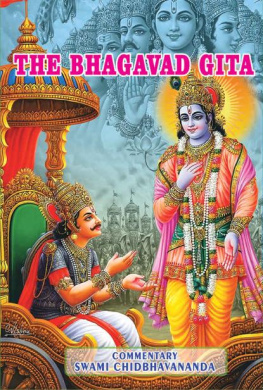
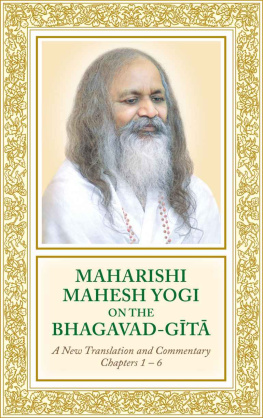
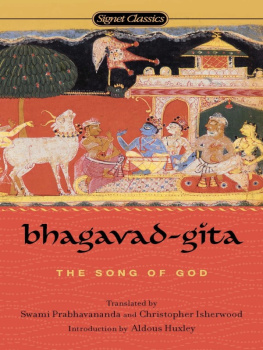
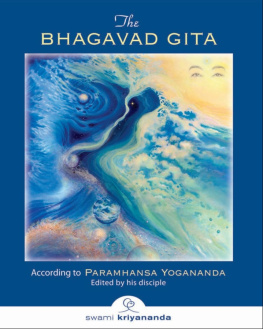



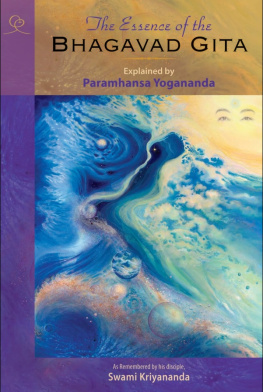
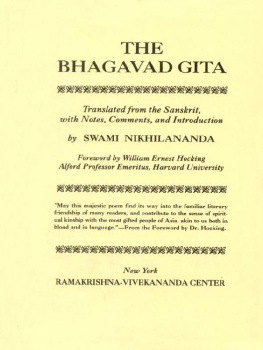
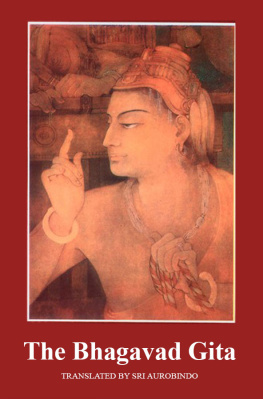










 ost of the verses in this edition of the Bhagavad Gita were taken from my much larger book, The Essence of the Bhagavad Gita Explained by Paramhansa Yogananda. That volume contained also deeply insightful commentaries on one of the great scriptures of the world, containing, as the "Gita" does, the essence of the Upanishads, which in their turn offer the essence of the timeless Vedas, the scriptural lore of ancient India.
ost of the verses in this edition of the Bhagavad Gita were taken from my much larger book, The Essence of the Bhagavad Gita Explained by Paramhansa Yogananda. That volume contained also deeply insightful commentaries on one of the great scriptures of the world, containing, as the "Gita" does, the essence of the Upanishads, which in their turn offer the essence of the timeless Vedas, the scriptural lore of ancient India.
 the Mahabharata, and the Bhagavad Gita of which it is a part, is not literal history. Rather it is a deep spiritual allegory, woven upon a framework of history. The main characters in the story did actually live, but they became essential reference points around which the story was developed. Most of the characters are inventions. They trace their names to Sanskrit roots, which supply their psychological meanings.
the Mahabharata, and the Bhagavad Gita of which it is a part, is not literal history. Rather it is a deep spiritual allegory, woven upon a framework of history. The main characters in the story did actually live, but they became essential reference points around which the story was developed. Most of the characters are inventions. They trace their names to Sanskrit roots, which supply their psychological meanings.